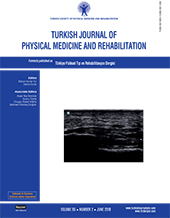The prevalence of comorbidity and predictors in ankylosing spondylitis
2 Department of Pathology, Pendik State Hospital, İstanbul, Turkey DOI : 10.5606/tftrd.2019.2822 Objectives: The aim of the present study was to investigate the prevalence of comorbidities and related factors in patients with ankylosing spondylitis (AS).
Patients and methods: Between June 2013 and January 2014, a total of 100 patients with AS (64 males, 36 females; mean age 43.1±10.7 years; range, 25 to 73 years) who were under routine follow-up in the outpatient clinic were included in this cross-sectional study. The demographic characteristics of the patients were recorded. The Ankylosing Spondylitis Disease Activity Scale (ASDAS), Bath Ankylosing Spondylitis Disease Activity Index (BASDAI), Bath Ankylosing Spondylitis Functional Index (BASFI), and Bath Ankylosing Spondylitis Metrology Index (BASMI) scores were calculated. Comorbidities were evaluated using the modified Cumulative Illness Rating Scale (CIRS). Both the number and severity of the affected systems were scored.
Results: The mean amount of cigarette consumption was 17.3±13.5 pack/year. The mean disease duration was 191.3±122.4 months. The BASFI, BASDAI, BASMI, and ASDAS-C-reactive protein scores were 3.4±2.3, 3.7±2.0, 4.5±1.8, and 2.5±0.9, respectively. The mean number of system-related problems was 4.3 (range, 1 to 11). The mean CIRS scores for the severity of comorbidities were 7.36±3.48 (range, 3 to 23). The most frequent system combinations were hematopoietic, eye, ear, nose and throat, and upper gastrointestinal in 11 patients, hematopoietic, respiratory and upper gastrointestinal in 11 patients, and hematopoietic, respiratory and eye, ear, nose and throat in 10 patients. When the estimated total CIRS scores was assessed in the multivariate reduced model, age, disease duration, and BASFI values showed a significant independent effect.
Conclusion: Our study results showed that the frequency of comorbidities was more than four, although the severity of system problems were mild in AS patients as measured by CIRS. The most frequently involved systems included hematopoietic, upper gastrointestinal, lower gastrointestinal, renal, and musculoskeletal-skin systems. Age, disease duration, and BASFI scores were found to be predictors of comorbidities in our patients.
Keywords : Ankylosing spondylitis, comorbidity, cumulative illness rating scale, predictors
















